Photocatalytic Decolorization of Dye with Self-Dye-Sensitization under Fluorescent Light Irradiation
Abstract
:1. Introduction
2. Materials and Methods
2.1. Materials
2.2. Characterization of Photocatalyst
2.3. Evaluation of Photocatalytic Activity
3. Results and Discussion
3.1. UV–Visible Analysis
3.2. Photocatalytic Decolorization of OII and MO with TiO2
3.3. Photocatalytic Decolorization of OII and MO with ZnO
3.4. Kinetic Analysis
3.5. Proposed Degradation Mechanisms
4. Conclusions
Supplementary Materials
Acknowledgments
Author Contributions
Conflicts of Interest
References
- Ong, W.J.; Tan, L.L.; Chai, S.P.; Yong, S.T.; Mohamed, A.R. Highly reactive {001} facets of TiO2-based composites: Synthesis, formation mechanism and characterization. Nanoscale 2014, 6, 1946–2008. [Google Scholar] [CrossRef] [PubMed]
- Zhang, Q.; Dandeneau, C.S.; Zhou, X.; Cao, G. ZnO nanostructures for dye sensitized solar cells. Adv. Mater. 2009, 21, 4087–4108. [Google Scholar] [CrossRef]
- Ni, M.; Leung, M.K.H.; Leung, D.Y.C.; Sumathy, K. A review and recent developments in photocatalytic water-splitting using TiO2 for hydrogen production. Renew. Sustain. Energy Rev. 2007, 11, 401–425. [Google Scholar] [CrossRef]
- Di Mauroa, A.; Cantarella, M.; Nicotra, G.; Privitera, V.; Impellizzeri, G. Low temperature atomic layer deposition of ZnO: Applications in photocatalysis. Appl. Catal. B Environ. 2016, 196, 68–76. [Google Scholar] [CrossRef]
- Impellizzeri, G.; Scuderi, V.; Romano, L.; Napolitani, E.; Sanz, R.; Carles, R.; Privitera, V. C ion–implanted TiO2 thin film for photocatalytic applications. J. Appl. Phys. 2015, 117, 105308. [Google Scholar] [CrossRef]
- Kim, W.; Tachikawa, T.; Majima, T.; Choi, W. Photocatalysis of dye–sensitized TiO2 nanoparticles with thin overcoat of Al2O3: Enhanced activity for H2 production and dechlorination of CCl4. J. Phys. Chem. C 2009, 113, 10603–10609. [Google Scholar] [CrossRef]
- Duncan, W.R.; Prezhdo, O.V. Theoretical studies of photoinduced electron transfer in dye-sensitized TiO2. Annu. Rev. Phys. Chem. 2007, 58, 143–184. [Google Scholar] [CrossRef] [PubMed]
- Wu, T.; Liu, G.; Zhao, J.; Hidaka, H.; Serpone, N. Photoassisted degradation of dye pollutants. V. Self-photosensitized oxidative transformation of rhodamine B under visible light irradiation in aqueous TiO2 dispersions. J. Phys. Chem. B 1998, 102, 5845–5851. [Google Scholar]
- Vinodgopal, D.; Kamat, P.V. Enhanced rates of photocatalytic degradation of an azo-dye using SnO2/TiO2 coupled semiconductor thin-films. Environ. Sci. Technol. 1995, 29, 841–845. [Google Scholar] [CrossRef] [PubMed]
- Xing, G.; Tang, C.; Zhang, B.; Zhao, L.; Su, Y.; Wang, X. A highly uniform ZnO/NaTaO3 nanocomposite: Enhanced self-sensitized degradation of colored pollutants under visible light. J. Alloy Compd. 2015, 647, 287–294. [Google Scholar] [CrossRef]
- Saikia, L.; Bhuyan, D.; Saikia, M.; Malakar, B.; Dutta, D.K.; Sengupta, P. Photocatalytic performance of ZnO nanomaterials for self-sensitized degradation of malachite green dye under solar light. Appl. Catal. A Gen. 2015, 490, 42–49. [Google Scholar] [CrossRef]
- Selvam, K.; Swaminathan, M. Photocatalytic synthesis of 2-methylquinolines with TiO2 Wackherr and Home Prepared TiO2-A comparative study. Arab. J. Chem. 2017, 10, S28–S34. [Google Scholar] [CrossRef]
- Liang, Y.; Guo, N.; Li, L.; Li, R.; Ji, G.; Gan, S. Fabrication of porous 3D flower-like Ag/ZnO heterostructure composites with enhanced photocatalytic performance. Appl. Surf. Sci. 2015, 332, 32–39. [Google Scholar] [CrossRef]
- Zhang, T.; Oyama, T.; Aoshima, A.; Hidaka, H.; Zhao, J. Serpone, hotooxidative N-demethylation of methylene blue in aqueous TiO2 dispersions under UV irradiation. J. Photochem. Photobiol. A Chem. 2001, 140, 163–172. [Google Scholar] [CrossRef]
- Turchi, C.S.; Ollis, D.F. Photocatalytic degradation of organic water contaminants: Mechanisms involving hydroxyl radical attack. J. Catal. 1990, 122, 178–192. [Google Scholar] [CrossRef]
- Lee, K.M.; Lai, C.W.; Ngai, K.S.; Juan, J.C. Recent developments of zinc oxide based photocatalyst in water treatment technology: A review. Water Res. 2016, 88, 428–448. [Google Scholar] [CrossRef] [PubMed]
- Huang, S.T.; Jiang, Y.R.; Chou, S.Y.; Dai, Y.M.; Chen, C.C. Synthesis, characterization, photocatalytic activity of visible-light-responsive photocatalysts BiOxCly/BiOmBrn by controlled hydrothermal method. J. Mol. Catal. A Chem. 2014, 391, 105–120. [Google Scholar] [CrossRef]
- Molla, M.A.I.; Tateishi, I.; Furukawa, M.; Katsumata, H.; Suzuki, T.; Kaneco, S. Evaluation of reaction mechanism for photocatalytic degradation of dye with self-sensitized TiO2 under visible light irradiation. Open J. Inorg. Non Met. Mater. 2017, 7, 1–7. [Google Scholar]
- Park, H.; Park, Y.; Kim, W.; Choi, W. Surface modification of TiO2 photocatalyst for environmental applications. J. Photochem. Photobiol. C Photochem. Rev. 2013, 15, 1–20. [Google Scholar] [CrossRef]
- Bessekhouad, Y.; Brahimi, R.; Hamdini, F.; Trari, M. Cu2S/TiO2 heterojunction applied to visible light Orange II degradation. J. Photochem. Photobiol. A Chem. 2012, 248, 15–23. [Google Scholar] [CrossRef]
- Prakash, O.; Kumar, S.; Singh, P.; Deckert, V.; Chatterjee, S.; Ghosh, A.K.; Singh, R.K. Surface-enhanced Raman scattering characteristics of CuO:Mn/Ag heterojunction probed by methyl orange: Effect of Mn2+ doping. J. Raman Spectrosc. 2016, 47, 813–818. [Google Scholar] [CrossRef]
- Pan, L.; Zou, J.; Liu, X.; Liu, X.; Wang, S.; Zhang, X.; Wang, L. Visible-light-induced photodegradation of rhodamine B over hierarchical TiO2: Effects of storage period and water-mediated adsorption switch. Ind. Eng. Chem. Res. 2012, 51, 12782–12786. [Google Scholar] [CrossRef]
- Su, Y.; Peng, L.; Guo, J.; Huang, S.; Lv, L.; Wang, X. Tunable optical and photocatalytic performance promoted by nonstoichiometric control and site-selective codoping of trivalent ions in NaTaO3. J. Phys. Chem. C 2014, 118, 10728–10739. [Google Scholar] [CrossRef]
- Fujishima, A.; Tao, T.N.; Tryk, D.A. Titanium dioxide photocatalysis. J. Photochem. Photobiol. C Photochem. Rev. 2000, 1, 1–21. [Google Scholar] [CrossRef]
- Maa, J.; Wang, K.; Li, L.; Zhang, T.; Kong, Y.; Komarnenib, S. Visible-light photocatalytic decolorization of Orange II on Cu2O/ZnO nanocomposites. Ceram. Int. 2015, 41, 2050–2056. [Google Scholar] [CrossRef]
- Vinodgopal, K.; Bedja, I.; Kamat, P.V. Nanostructured semiconductor films for photocatalysis. Photoelectrochemical behavior of SnO2/TiO2 composite systems and its role in photocatalytic degradation of a textile azo dye. Chem. Mater. 1996, 8, 2180–2187. [Google Scholar] [CrossRef]
- Iliev, V. Phthalocyanine-modified titania-catalyst for photooxidation of phenols by irradiation with visible light. J. Photochem. Photobiol. A Chem. 2002, 151, 195–199. [Google Scholar] [CrossRef]
- Turkten, N.; Cinar, Z. Photocatalytic decolorization of azo dyes on TiO2: Prediction of mechanism via conceptual DFT. Catal. Today 2017, 287, 169–175. [Google Scholar] [CrossRef]
- Konstantinou, I.K.; Albanis, T.A. TiO2-assisted photocatalytic degradation of azo dyes in aqueous solution: Kinetic and mechanistic investigations. A review. Appl. Catal. B Environ. 2004, 49, 1–14. [Google Scholar] [CrossRef]
- Xie, S.; Huang, P.; Kruzic, J.J.; Zeng, X.; Qian, H. A highly efficient degradation mechanism of methyl orange using Fe-based metallic glass powders. Sci. Rep. 2016, 6. [Google Scholar] [CrossRef] [PubMed]
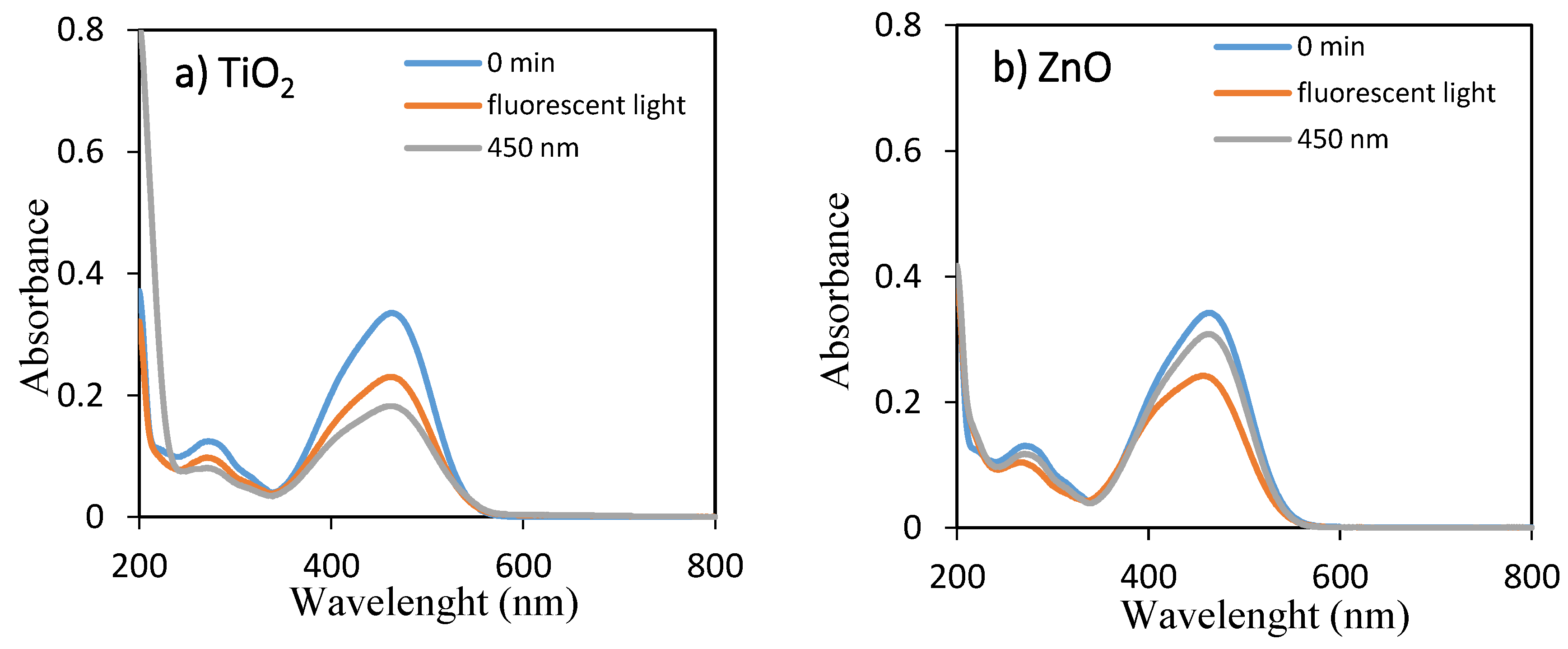
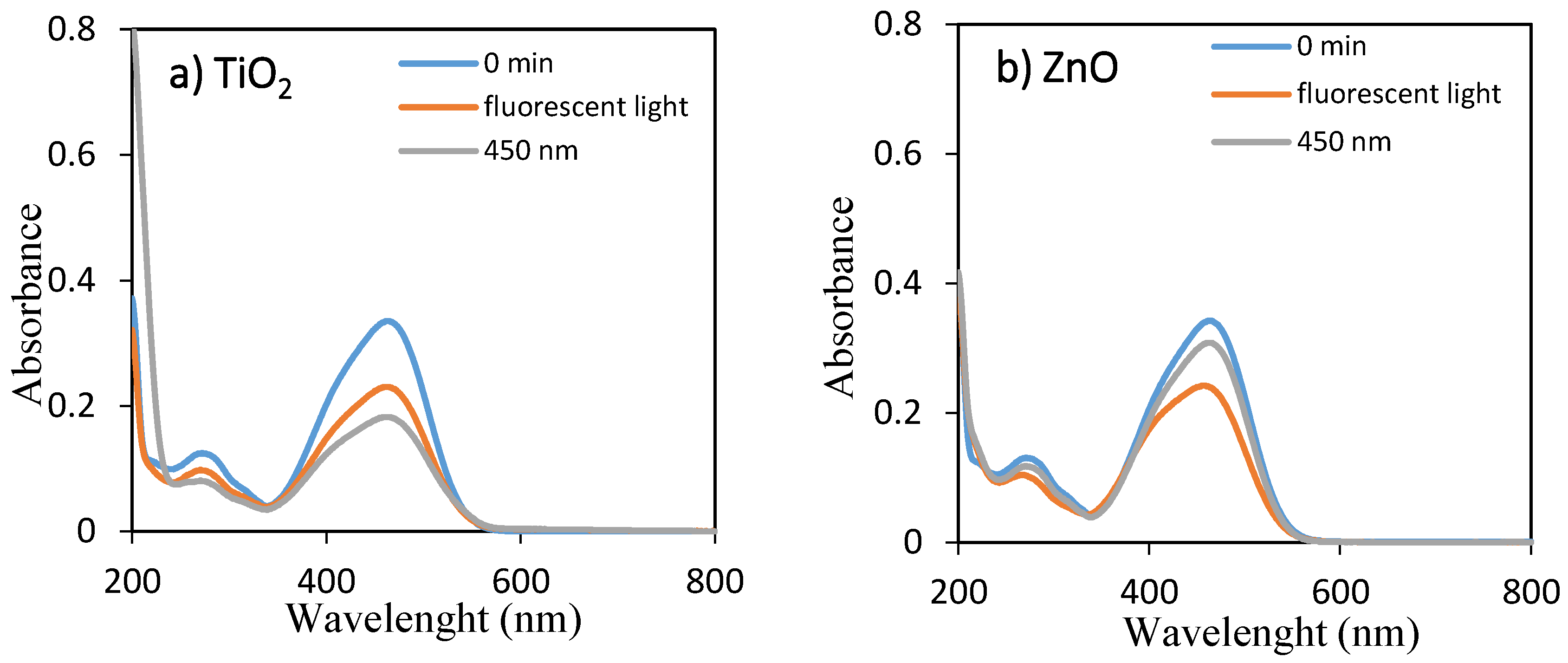
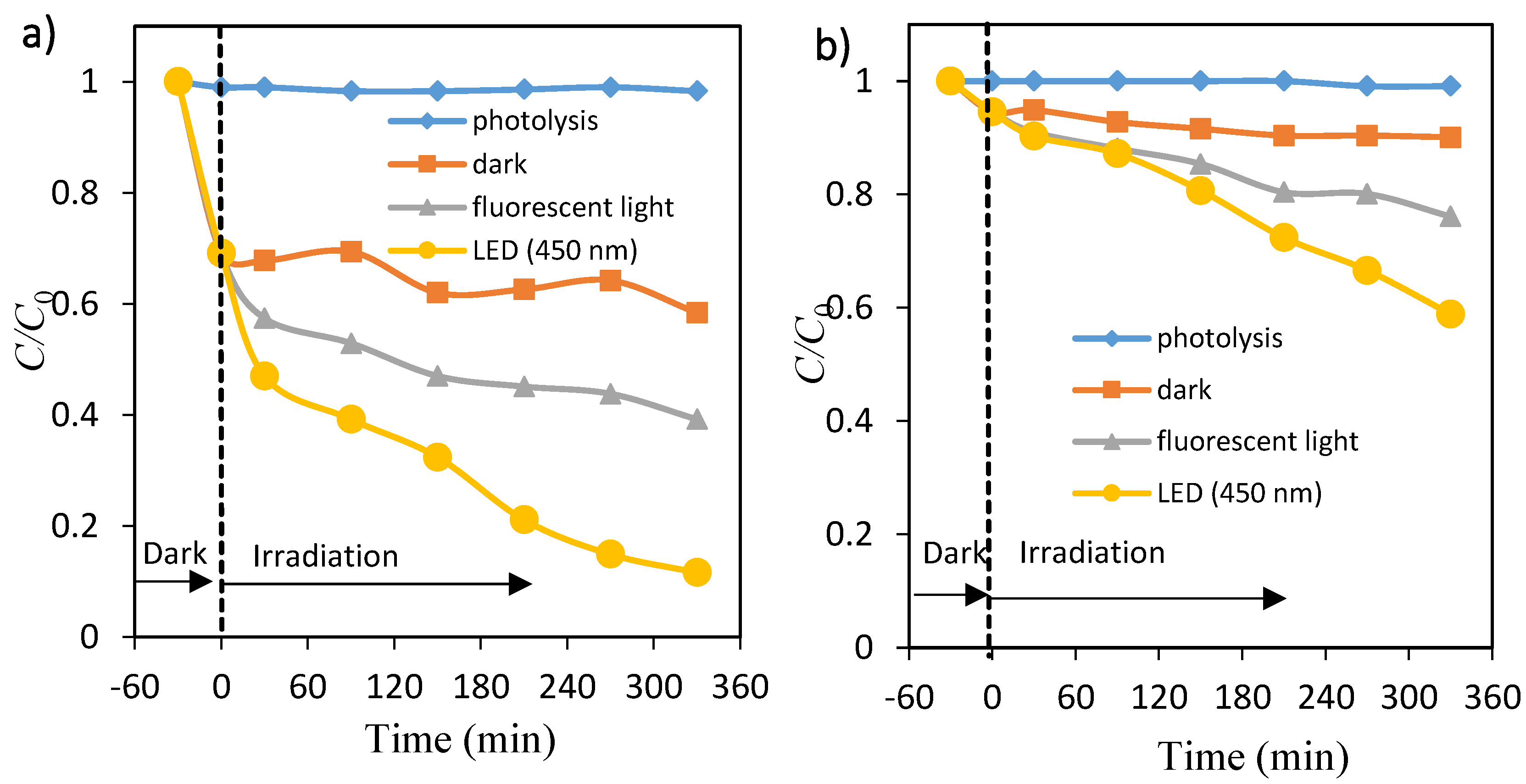
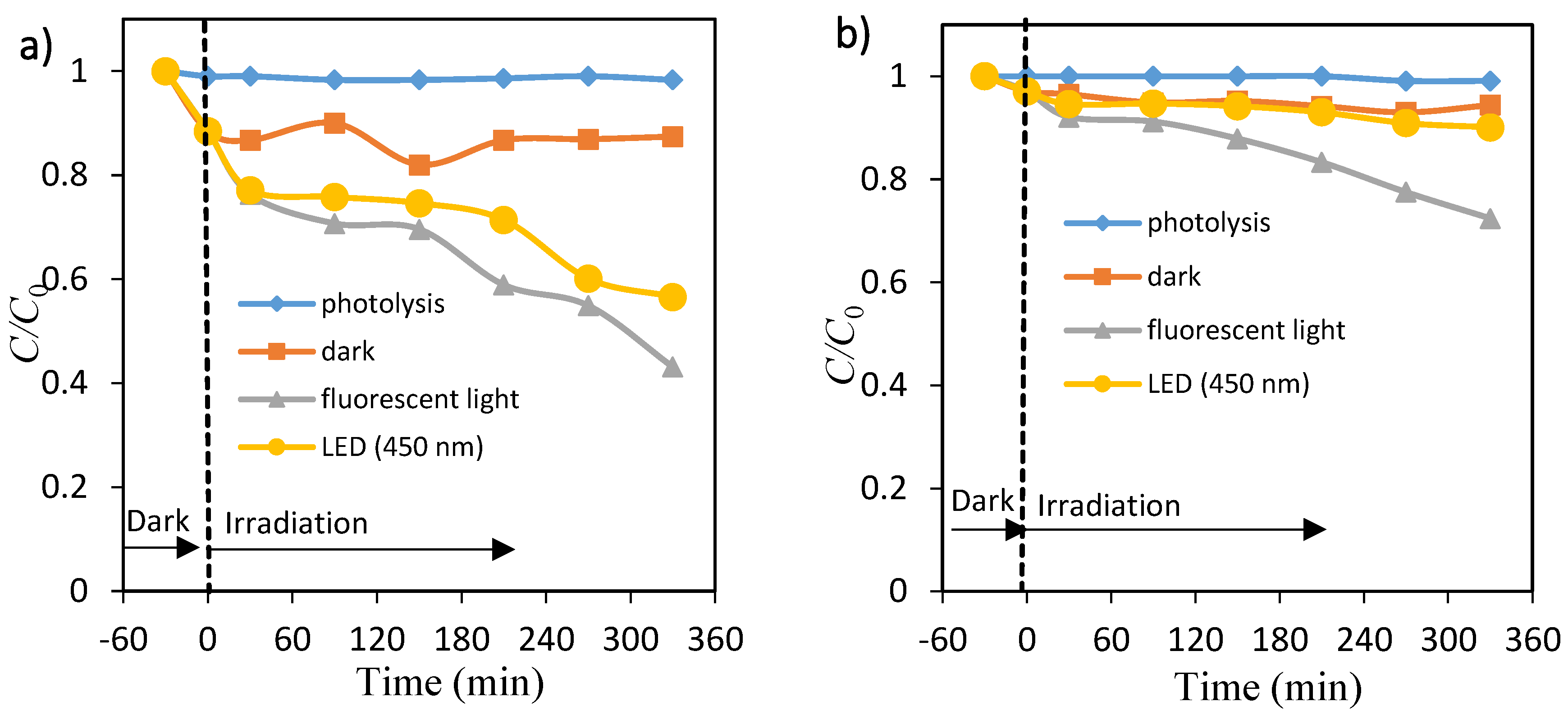
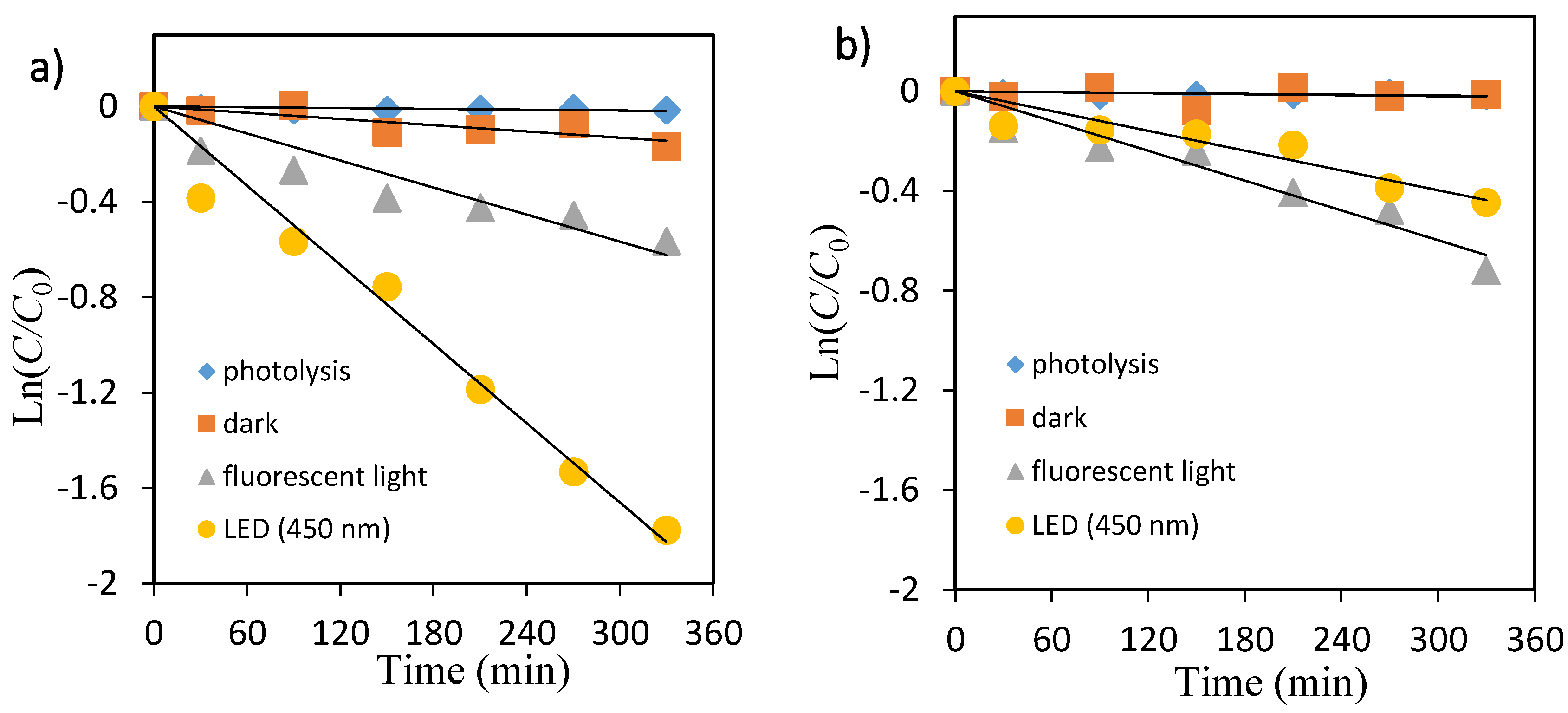
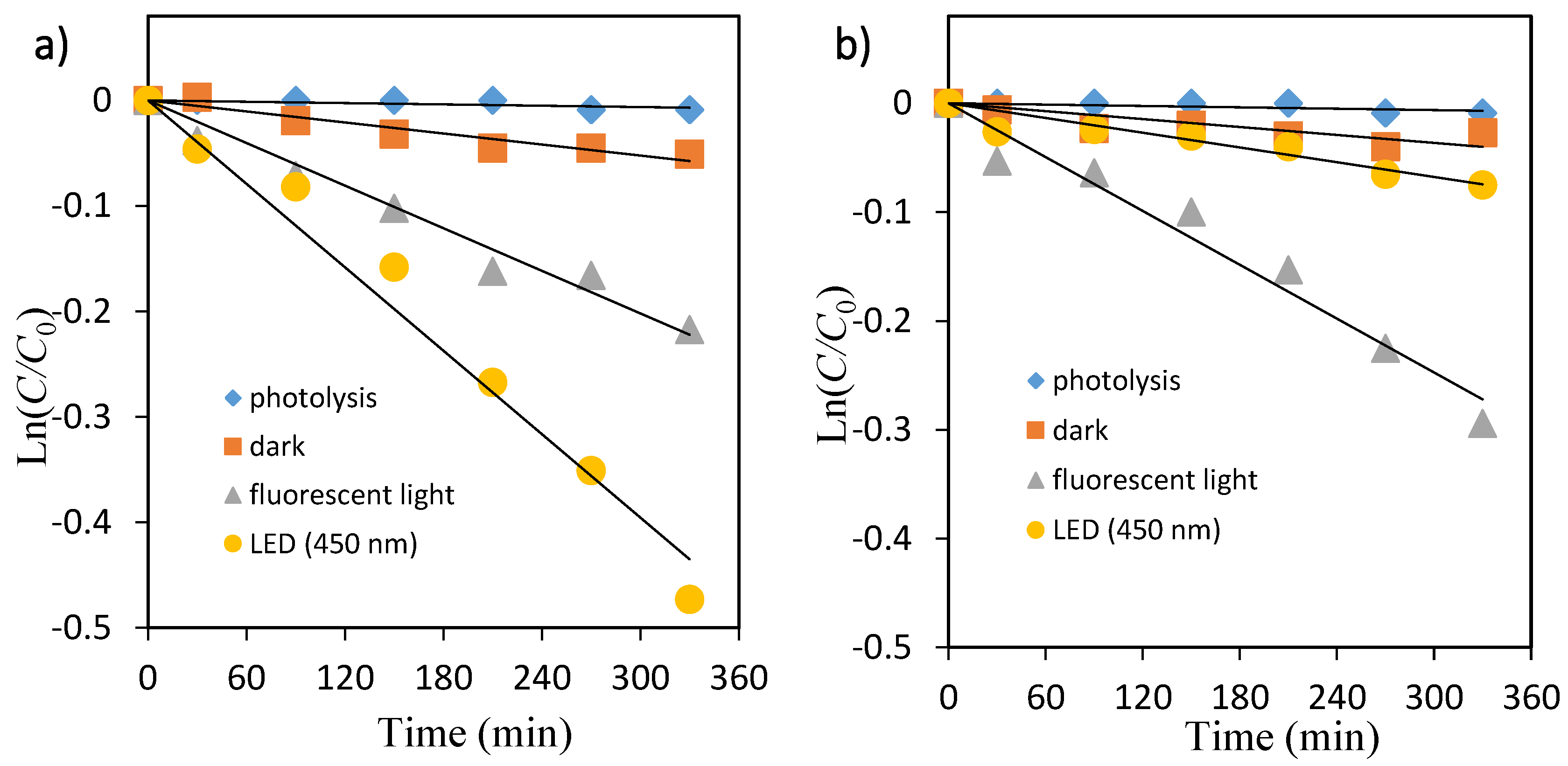
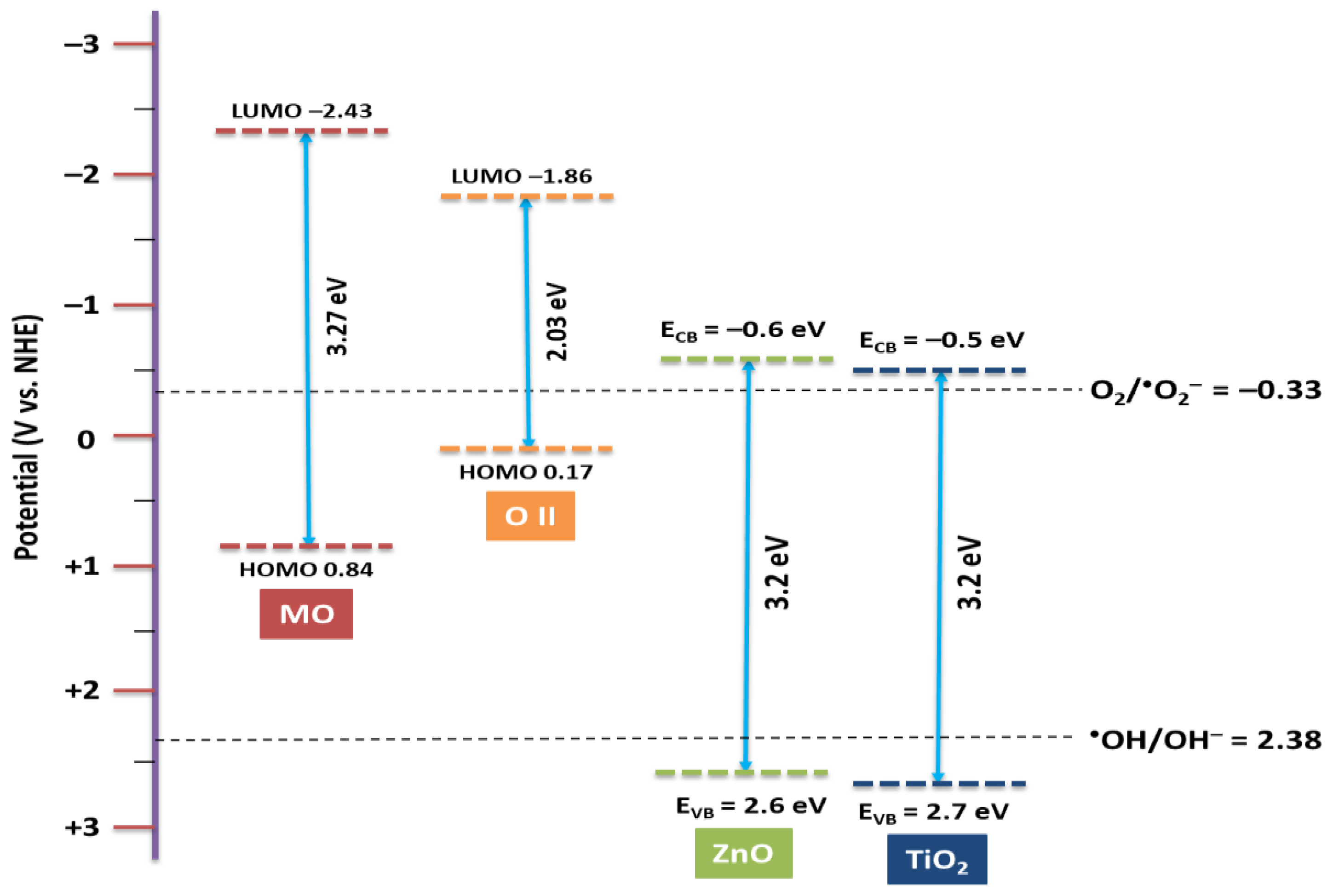
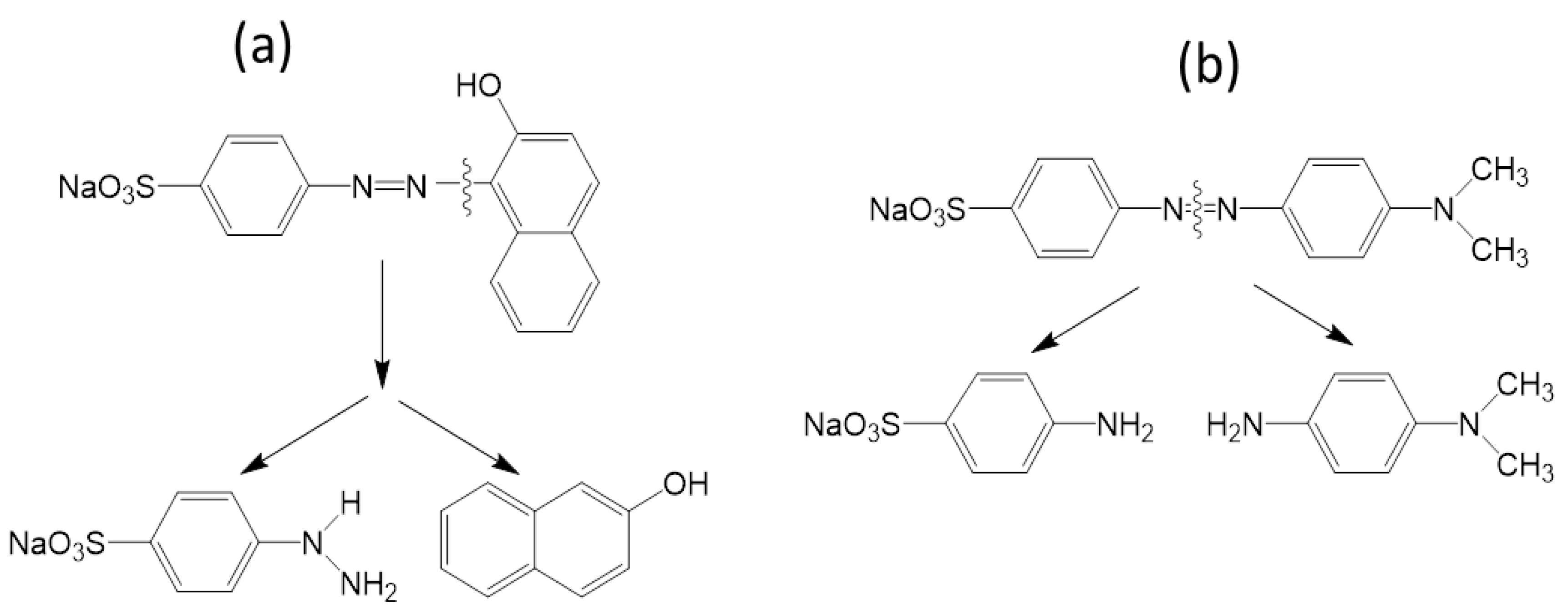
| Samples | Orange II (5 mg/L,30 mL) Methyl orange (5 mg/L, 30 mL) |
| Photocatalyst | P25 TiO2 (20 mg) Aldrich ZnO (20 mg) |
| Temperature | Room temperature (25 °C) |
| pH | 6 |
| Light source | 450 nm LED light (5.14 mW/cm2) Fluorescent light (0.034 mW/cm2) |
| λmax | Orange II (485 nm), methyl orange (464 nm) |
| Irradiation time | 6 h |
| Light Source | Catalysts | kobs (min−1) | R2 | t1/2 (min) | |||
|---|---|---|---|---|---|---|---|
| OII | MO | OII | MO | OII | MO | ||
| Fluorescent light | TiO2 | 0.0019 | 0.00067 | 0.80 | 0.97 | 367 | 1029 |
| ZnO | 0.0019 | 0.00083 | 0.93 | 0.96 | 346 | 866 | |
| LED light | TiO2 | 0.0055 | 0.0013 | 0.97 | 0.98 | 125 | 525 |
| ZnO | 0.0013 | 0.00023 | 0.88 | 0.88 | 533 | 3465 | |
© 2017 by the authors. Licensee MDPI, Basel, Switzerland. This article is an open access article distributed under the terms and conditions of the Creative Commons Attribution (CC BY) license (http://creativecommons.org/licenses/by/4.0/).
Share and Cite
Molla, M.A.I.; Tateishi, I.; Furukawa, M.; Katsumata, H.; Suzuki, T.; Kaneco, S. Photocatalytic Decolorization of Dye with Self-Dye-Sensitization under Fluorescent Light Irradiation. ChemEngineering 2017, 1, 8. https://doi.org/10.3390/chemengineering1020008
Molla MAI, Tateishi I, Furukawa M, Katsumata H, Suzuki T, Kaneco S. Photocatalytic Decolorization of Dye with Self-Dye-Sensitization under Fluorescent Light Irradiation. ChemEngineering. 2017; 1(2):8. https://doi.org/10.3390/chemengineering1020008
Chicago/Turabian StyleMolla, Md. Ashraful Islam, Ikki Tateishi, Mai Furukawa, Hideyuki Katsumata, Tohru Suzuki, and Satoshi Kaneco. 2017. "Photocatalytic Decolorization of Dye with Self-Dye-Sensitization under Fluorescent Light Irradiation" ChemEngineering 1, no. 2: 8. https://doi.org/10.3390/chemengineering1020008
APA StyleMolla, M. A. I., Tateishi, I., Furukawa, M., Katsumata, H., Suzuki, T., & Kaneco, S. (2017). Photocatalytic Decolorization of Dye with Self-Dye-Sensitization under Fluorescent Light Irradiation. ChemEngineering, 1(2), 8. https://doi.org/10.3390/chemengineering1020008






